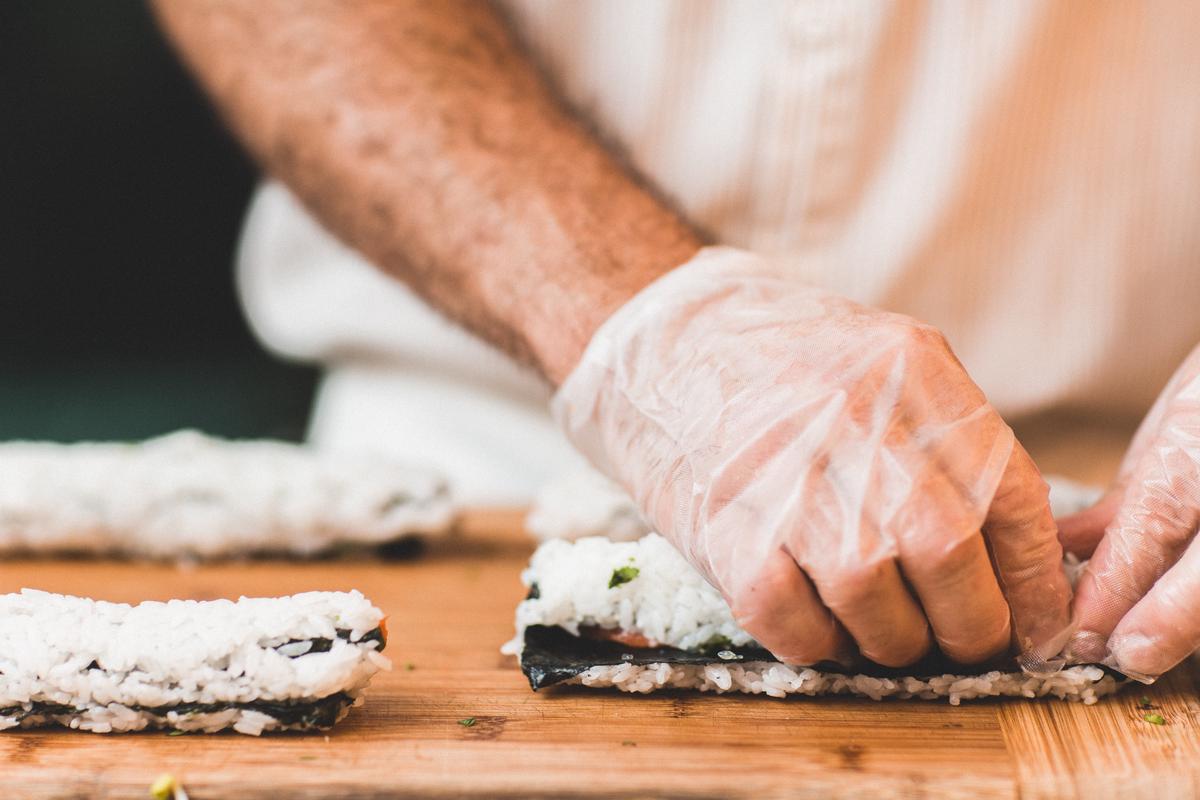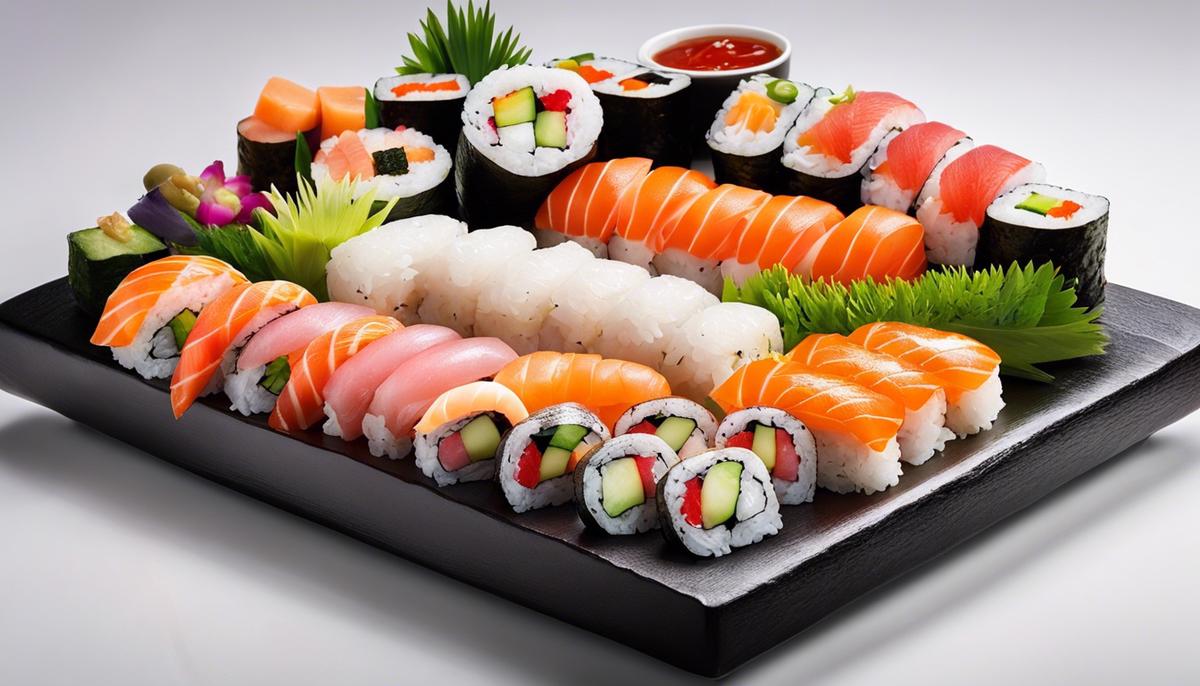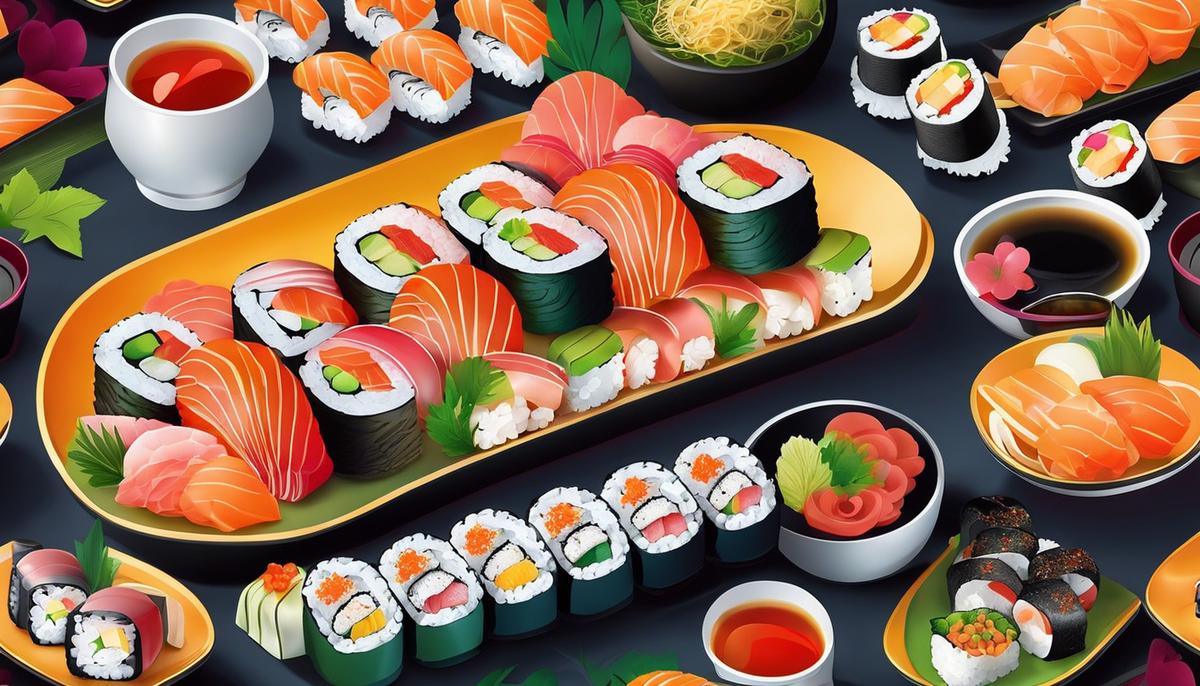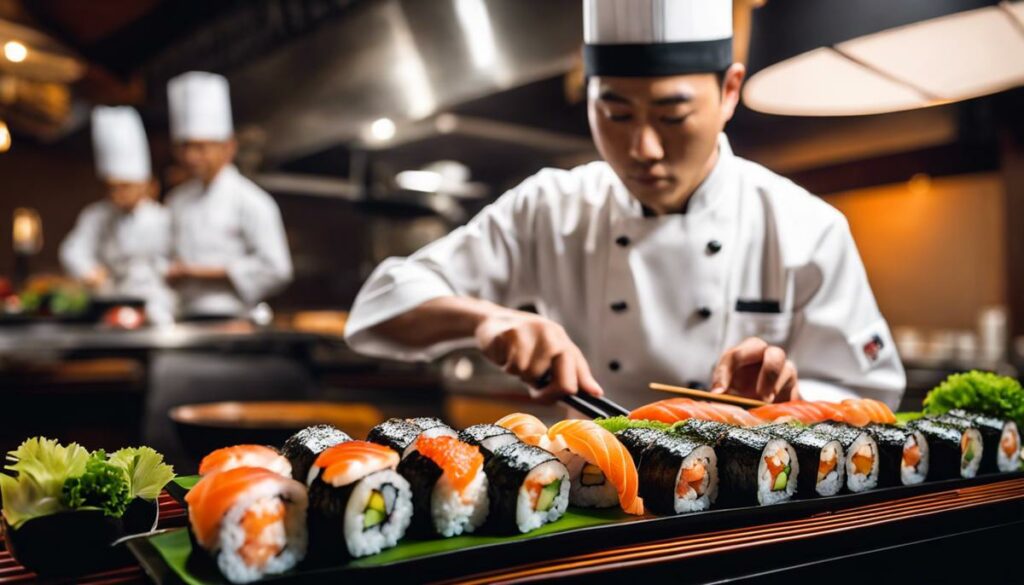The smell of fresh fish, the sound of sharp knives on bamboo mats and the filigree artistry with which each sushi roll is shaped – this is how the ordinary yet extraordinary everyday life of a sushi chef begins. Like any art form, sushi cooking requires precise technique, undivided attention, and a lot of dedication. From the meticulous preparation of each ingredient to the virtuoso display of the finished sushi rolls, everything is a testament to the artisanal finesse and passion that characterize this traditional Japanese cuisine.
The Art of Sushi Cooking
The process of cooking sushi paves the way for a harmonious and peaceful atmosphere. It is the art of capturing and appreciating the sharp contrast between structured precision and organic creativity.
For any connoisseur of the intricacies of Asian culture, especially Japanese aesthetics, sushi cooking is a form of meditation. The concentrated calm that is felt is a real joy and shows the deep connection between body and mind. Every step in the preparation is a conscious act that tempts us to focus on the moment and find an inner balance.
It’s not just the delicate elements of sushi that make it special. It is the careful representation of the meal on the plate that is a feast for the eyes and a real cocktail for the senses. This is where the crux of aesthetics comes to light. The color contrast, the arrangement of the sushi pieces, the play with different surfaces – all this contributes to creating a visual experience worthy of admiration.
No one will deny that the trend of eating sushi goes hand in hand with the increasing interest in Japanese culture. However, what really makes sushi cooking a meditative process is the respect for the food that it fosters. The pleasure of knowing that careful preparation and presentation make all the difference is second to none.
The aesthetics of sushi cooking remind us to make time for the things in life that bring us joy. It’s not just about preparing a meal, it’s about the experience associated with every ingredient and every step of the process. It’s the art of enjoying the moment and finding the beauty in the little things. Like the careful alignment of a fish slice, the devotion to the perfect rice, or the arrangement of a vibrant array of colors – together, they create unique beauty.
The world of sushi cooking is indeed meditative and aesthetically pleasing. It is the blend of technique, creativity and dedication that makes it an art. Do yourself a favor and give it a try—if not for cooking, then for enjoyment.

Photo by epicurrence on Unsplash
The technical procedures of a sushi chef
At dawn, the sushi chef enters the fish market, keeping a watchful eye on the freshest catches. Choosing the right ingredients is an essential element of sushi preparation – and this task is perceived as much more than just an afterthought. Every salmon, tuna and oyster is thoroughly inspected before it finds its way into the kitchen. Quality and freshness are prerequisites here, not luxury goods.
After the ingredients have been meticulously selected and the stressful part of the market has been completed, the real work begins. In the kitchen, the sushi chef begins his sacred ceremony, during which raw materials are transformed into delicious dishes. The chef prepares the rice and cooks it to perfection – a critical step that is often overlooked, but is crucial. The rice is the foundation, the heart of sushi, and must be prepared with great care and dedication.
While the rice is cooking, the sushi chef takes care of the fish. With precise, flowing movements, the fish is filleted, deboned and cut into perfect pieces. This is a job that requires skill, accuracy, and a deeper understanding of the raw materials. The fish must be treated with respect, and every hand gesture should comply with this principle.
Next comes the most beautiful part of the process: rolling. Here, the prepared rice is gently and evenly placed on the nori sheet (seaweed), and the fish is elegantly placed on top. Then everything is rolled up – an act that is both art and science. This is where the skill and years of experience of the sushi chef really become apparent.
The last step is the presentation. Each roll is carefully draped on a specially designed plate, often paired with soy sauce, wasabi and ginger. This final act of presentation is not only a matter of aesthetics, but also an invitation to the guest to enjoy the meal with all their senses.
For the sushi chef, the day ends not only when the last roll is served, but when he sees the satisfaction and joy on the faces of his guests. It is his affirmation, his sign of appreciation – a quiet contentment that can only be achieved through a work of the heart. Cooking sushi is more than just a profession, it’s a calling… a journey of self-discovery and expression. It’s an impressive symphony of taste, culture, and craftsmanship that delves deep into the soul of Japanese cuisine.
Treat yourself to this experience, taste this art and become part of this beautiful and awe-inspiring tradition. Because it’s not just the food you enjoy, it’s the life-affirming philosophy and culture behind it.
Tastes life… tastes sushi.

The Cultural Influence and Modern Trends in Sushi Cooking
How do these contemporary culinary arts and lifestyles reconcile traditional values? The secret is in balance. By combining old and new, the art of sushi creates an intriguing blend of tradition and innovation.
The selection of ingredients plays a crucial role in the art of sushi and refers to the appreciation of nature and its products. High-quality, fresh ingredients are of paramount importance – this is a culter carried over into the modern age. Respect for nature’s resources and the desire to display its gifts are the guiding principles.
Rice also plays an essential role in this. In a demanding process that requires precision and care, it is cooked and prepared for optimal flavor and texture. The rice is fundamental, the heart of every piece of sushi, and this is evident in the care that goes into its preparation.
The process of filleting and cutting the fish is an art in itself. This is where craftsmanship and sensitivity come together to get the best out of every piece of fish. Respect for the animal, its transformation into a delicacy, is an act of worship and requires accuracy and experience.
Although sushi can also be considered fast food, the art of rolling it up reflects skill and patience. When you hold these rolls in your hand, you feel the work that goes into them and discover their complex tastes.
Sushi isn’t just for eating, it’s also for watching. The presentation of the rolls is an exquisite part of the experience and showcases the aesthetics of sushi art. Each scroll is a small work of art that invites the viewer to appreciate it.
It is the ultimate goal to bring joy to the guests. Their satisfaction is the best endorsement for the artist and rewards the hard work that goes into these culinary masterpieces.
This profession goes beyond the simple act of cooking sushi. It’s about creating joy, connecting with guests, and passing on culture and knowledge.
After all, sushi is more than just nutrition, it is an expression of taste, culture and craftsmanship. It symbolizes a life-affirming philosophy and culture and brings us closer to the joys of life.
With these thoughts in mind, you can reinterpret sushi – not only as food, but as a diagram of lifestyles and cultural understanding. With every bite, we feel and taste a piece of the world and human creativity.

The world of sushi cooking is an intriguing balance of tradition and innovation, craftsmanship and artistic expression. With every salmon fillet filleted, every grain of rice that fits into a perfect sushi roll, and every happy customer who bites into a special delicacy with their eyes closed, the importance and influence of this unique culinary art form is further amplified. Whether you’re a traditional sushi chef or a newcomer to the sushi world, one thing remains clear: the art of sushi cooking is a sensual, fulfilling, and lifelong passion that always demands perfection and dedication.


